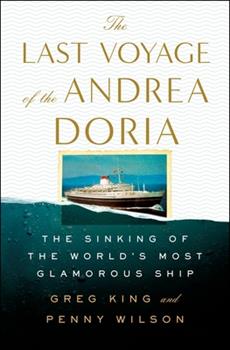Tragedies at Sea: Outstanding Historical Writing
By Marcia Allen, Collections Manager

Are you familiar with the story of the Andrea Doria? She was a luxury liner, built after World War II, well known for elegantly appointed rooms and gourmet meals. The ship frequently hosted celebrities such as film actresses and business CEO’s. With a capacity of some 1200 passengers and a crew of about 500, she was touted as one of the safest and speediest ships on the ocean. A freakish tragedy in July of 1956, however, proved otherwise.
Greg King and Penny Wilson have just published an excellent piece of historical nonfiction entitled “The Last Voyage of the Andrea Doria” that dramatically recounts that final excursion. We learn of the craftsmanship that went into the liner; we learn of its sterling reputation as something of a floating palace; we discover the roster of passengers who ventured to travel from Genoa to New York on the fateful voyage.
What makes this book exceptional? The backgrounds of a few of the personalities is a start. Because we learn so much about their past experiences, their plans, and their relationships with other passengers, we come to see them individuals which lends a personal immediacy to the story. We learn, for example, that Captain Piero Calamai was a shy fellow, devoted to the welfare of his passengers and his beloved ship, a man who never raised his voice to erring crew members. We discover the heartbreak of Thure and Martha Peterson, a couple devoted to each other, who had saved money for many years to travel to sites where their parents were born in Sweden. They were able to extend their trip to sightsee in France, but their delayed return to the U.S. placed them on the decks of the Andrea Doria.
What also elevates this book is its excellent research into the last hours of the voyage. In dramatic detail, King and Wilson recount the coincidental chain of events that caused a horrendous collision. Thick fog off the coast of Nantucket and a change in the departure route by the stoutly built liner called the Stockholm brought the two ships into contact. Last-minute efforts to avoid collision drove the raked and reinforced bow of the Stockholm into the starboard side of Andrea Doria, penetrating several decks.
The outcome is what you would expect. Lives were lost, but most passengers stranded at sea were rescued by immediate responses of all available watercraft. The Andrea Doria sank some hours later, and legal courts later determined who was to be blamed. King and Wilson have written a masterful account of all that occurred that day in July.
To my amazement, King and Wilson had written a previous book about the sinking of the Lusitania. Entitled Lusitania, that older book has some of the same flavor of the Andrea Doria story, with personality studies, ship history, and vivid details about the actual sinking. But that is where the similarities between the two stories ends.
First of all, the demise of the Lusitania was no accident. In the midst of World War I, British forces had chosen to ignore standard Cruiser Rules, under which ships were required to post their authentic flags and avoid any camouflage of colors or markings. The British decided to ignore such rules. Secondly, the Lusitania was known to carry munitions intended for the British, as America had agreed to be a wartime supplier for the British. That made the ship fair game for German forces.
It was only by luck that Kapitanleutnant Schwieger, commanding U-20, spotted the British liner. Seeing his opportunity in the middle of a war zone, he fired a torpedo that inflicted a death blow to the ship. The Lusitania, long thought to be unsinkable, foundered on its side, disabling lifeboats and crippling many passengers, and managed to stay afloat only 18 minutes more.
The loss of life in this book is heartbreaking. Hundreds of victims were never found, and many of those who did survive were emotionally shattered. Because there were no preparations for evacuation on board and because there was a shortage of life jackets, loss rates skyrocketed. And subsequent court trials did little to assure that future disasters could be avoided.
I strongly advise reading one or both of these books. While we may not be drawn to disaster reading, both create a sense of immediacy that is so often missed in historical accounts. We become close observers of tragedies at sea and we realize a clearer understanding of the causes. And the eyewitness testimonies are incredible to read. Excellent reading.

